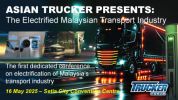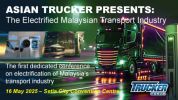Scania to Drive Customer Profitability through Sustainable Transport Solutions
Scania is aiming to lead the shift to a sustainable transport system by identifying value-driving activities, removing non-contributing costs and reinvesting in strategic growth initiatives that improve competitiveness.
Its Group President and Chief Executive Officer (CEO), Henrik Henriksson was recently in Malaysia to talk about internal issues with the top management here and took some time to meet with the press to talk about Scania's sustainable transport direction.
He said it was all about moving people and goods while contributing to economic and social development, without jeopardising human health and safety or endangering the environment.
"For Scania it is evident that sustainability and profitability go together, here and now and increasingly so in the future. I think businesses that are not part of developing solutions to the sustainability challenges of our time will struggle to survive. For us the question is not whether a future of sustainable transport will come, but when. It is towards this future that we are working in close cooperation with our customers and customers’ customers,” he added.
Asia has been one of the most encouraging area for Scania, said Henriksson, where business model, which focuses on total operating economy and vehicle uptime, is starting to resonate with customers.
Scania tailors solutions that eliminate waste and improve efficiencies in the entire transport flow based on its three-pillar approach to sustainable transport, namely energy efficiency; alternative fuels and electrification; and smart and safe transport, which includes vehicles and services.
That approach saw Scania’s net sales rising to a record high in 2017, during which it intensified its efforts to drive the shift towards a sustainable transport system, with an increase of 15 percent compared to the previous year. Meanwhile vehicle orders surpassed 100 000 for the first time as order bookings for trucks rose by 30 percent compared to the previous year.
“Our success is built on our ability to provide profitable and sustainable transport solutions that contribute to the success of customers' businesses. Scania’s business model, our principles, working methods and approach to sustainable transport will continue to be the platform for how we create value for our stakeholders.”
This includes initiatives where Scania was the first in Malaysia to introduce an enhanced and industry-leading three-year warranty with unlimited mileage, with three-year Scania Assistance and 10-year Scania Fleet Management for the trucks sold for operators to get the best Total Operating Economy.
“We work across boundaries with cities, operators and their customers too, taking the whole transport system into consideration. The world can’t wait for a ‘one size fits all’ solution; the conditions and issues vary so much from place to place. We urge authorities and institutions to enable and simplify the use of them all.
“Our aim is that wherever in the world you go to buy a Scania solution, sustainable solutions is the standard offer and fossil-fuelled the alternative,” Henriksson said.
The good news, Henriksson added, is that Scania’s customers do not have to wait to adapt their businesses to a sustainable transport system because the solutions are already available with Scania's broad range of platforms and services now, to support customers' businesses.
Scania to Drive Customer Profitability through Sustainable Transport Solutions
Scania's Potential to Expand in Sarawak
Seeking Support for CSR Initiative
Seeking Support for CSR Initiative
The season of giving will soon be upon us. This Ramadan, the Asian Trucker Drivers’ Club will be visiting the Rumah Bakti Cahaya Hati, an orphanage in Rawang, Selangor.
On May 27, members of the club will bring a variety of potluck dishes to treat some 50 residents of the orphanage for the breaking of fast. The orphanage houses over 30 children between the ages of three months and 17 years old.
Unlike past club activities, this time members will have the opportunity to give back to the community. Besides homecooked meals, they will also contribute daily household needs like milk, detergent and groceries besides items for Hari Raya preparations including clothes, cookies and some “Duit Raya.”
The orphanage has 13 little children aged 5 and below, and 20 bigger kids aged 6-17. For the smaller kids we estimate RM120 each, and for the bigger kids RM150 each.
Rumah Bakti Cahaya Hati (Orphanage with 30 children 2-18 years old)
Address: 2, Jalan 7a/6, Bandar Tasik Puteri, 48000 Rawang, Selangor
Date of CSR Event: 27 May 2018
Time: 5pm onwards (for break of fast)
Contribution from club members: Potluck for buka puasa and additional donations eg used clothes and household items.
Contribution from Sponsor: RM 3 000 for clothes to be donated to the Orphanage. The initiative will be featured across Asian Trucker’s various platforms, giving sponsor(s) exposure.
Asian Trucker and its club members are looking forward to meeting the children of Rumah Bakti Cahaya Hati, and hope to bring some joy in their home for this coming festive season.
To become a sponsor, please contact:
Shell Forecasts Potential LNG Shortage as Demand Exceeds Expectations
Shell is seeing a potential liquefied natural gas (LNG) supply shortage developing in mid-2020’s, unless new LNG production project commitments are made soon.
This is based on current demand projections, where the global LNG market continues to exceed expectations of many market observers, with demand growing by 29 million tonnes to 293 million tonnes in 2017, according to Shell’s annual LNG Outlook.
Japan remained the world’s largest LNG importer in 2017, while China moved into second place as Chinese imports surged past South Korea’s. Total demand for LNG in China reached 38 million tonnes, a result of continued economic growth and policies to reduce local air pollution through coal-to-gas switching.
Maarten Wetselaar, Integrated Gas and New Energies Director at Shell said they were still seeing significant demand from traditional importers in Asia and Europe, but were also seeing LNG provide flexible, reliable and cleaner energy supply for other countries around the world.
In Asia alone, demand rose by 17 million tonnes. That is nearly as much as Indonesia, the world’s fifth-largest LNG exporter, produced in 2017,” he said in a statement.
LNG has played an increasing role in the global energy system over the last few decades. Since 2000, the number of countries importing LNG has quadrupled and the number of countries supplying it has almost doubled. LNG trade increased from 100 million tonnes in 2000 to nearly 300 million tonnes in 2017. That is enough gas to generate power for around 575 million homes.
LNG buyers continued to sign shorter and smaller contracts. In 2017, the number of LNG spot cargoes sold reached 1 100 for the first time, equivalent to three cargoes delivered every day. This growth mostly came from new supply from Australia and the USA.The mismatch in requirements between buyers and suppliers is growing. Most suppliers still seek long-term LNG sales to secure financing. But LNG buyers increasingly want shorter, smaller and more flexible contracts so they can better compete in their own downstream power and gas markets.
This mismatch needs to be resolved to enable LNG project developers to make final investment decisions that are needed to ensure there is enough future supply of this cleaner-burning fuel for the world economy.
Shell Malaysia Celebrates with Key Customers and Winners of Shell Rimula Ultimate Stopover Promotion
Shell Malaysia Technology and Innovation Conference for Construction Sectors Draws Experts Together
Sightseeing in the Silent Hop-on/hop-off bus in London
Singapore: Wi-Fi on SBS Transit Bus Services from February 2019
Singapore's Hop-On Hop-Off Tour Bus Among the World's Best
Singapore’s Commuters Want Buses to be More Inclusive
Singapore’s Sentosa To Start Autonomous On-Demand Bus Trial Starting 2019
Singapore’s Woodlands Toll Charges:Dropped or Reduced
Transport and logistic providers in Malaysia welcomed with open hands the decision by the Land Transport Authority of Singapore to revise toll charges for vehicles entering and leaving the republic via the Woodlands Checkpoint effective 1 February 2018. Toll charges for vehicles entering the Republic through Woodlands checkpoint will be removed, while all vehicles (except motorcycles) leaving Singapore via Woodlands will see reduced charges.
This was in line with Singapore's long-standing policy of matching Malaysia's toll rates. Malaysia previously announced the removal of toll charges at the Causeway for the Eastern Dispersal Link (EDL) since 1st January 2018. Malaysia’s Prime Minister Datuk Seri Najib Tun Razak had announced previously in October that the EDL toll fee would be removed.
The EDL is an 8 kilometres long and ends at the Causeway from Johor Bharu. Toll fees were collected since 2014 from vehicles going into as well as leaving Singapore, even if some of those vehicles did not pass through the highway, which had been constructed by a firm linked to the Malaysian government.
Pan-Malaysian Lorry Owners Association (PMLOA) President Anthony Tan said that Singapore's move would help to improve and increase cross-border trade between Malaysia and Singapore."It will decrease the cost of sending goods to and from Singapore," he said.Tan hopes the Malaysian government will also reduce or abolish toll charges at the Second Link Crossing in Tanjung Kupang, Johor. Tan said trucks from the central and northern parts of Malaysia and north of Johor such as Batu Pahat, Muar and Senai could use the Second Link while those from the central, east and south of Johor could use the Causeway.He said there were about 3000 Malaysian-registered trucks using the Johor Causeway daily.
Johor South SME Association President Teh Kee Sin said the revision was good news for thousands of Malaysians who commuted to the republic daily from Johor Bharu.Malaysian Indian Commerce Association President P. Sivakumar said the impact would be especially good for the development of the special economic zone Iskandar Malaysia.
Previously, car owners paid S$3.80 (RM11.24) and S$2.70 (RM7.99) when leaving and entering Singapore. From 1st of February, they will only need to pay S$1 (RM2.96). The accumulation of savings could add up to quite a substantial amount considering it is more than 50% reduction in price. Vans and light goods vehicles will pay S$1.50 (RM4.44) for a return trip instead of S$9.80(RM 28.99) while heavy goods vehicles will pay S$2 (RM5.92) instead of S$13(RM 38.45). Taxis will pay 50 (RM1.48) cents instead of S$3.30 (RM9.76) and buses will pay 80 cents (RM2.37) instead of the initial S$5.30 (RM15.68).
The LTA also reminded motorists to ensure that there is sufficient value in their Autopass cards before driving through the checkpoints, in order to minimise longer queues at the toll gates.“Motorists who evade payment of the tolls, fees and charges are liable to pay a composition sum of SGD50, while repeat offenders will have to pay SGD100. Motorists who do not pay the composition sum may be charged in court and are liable to a fine not exceeding SGD1000 or to imprisonment for a term not exceeding three months for the first offence," said LTA in a statement.
However, LTA did not indicate any changes to the tolls rates for vehicles going in and out from Singapore from the Tuas checkpoint. It is understood that the revised toll charges only apply to the Woodlands checkpoint only.








